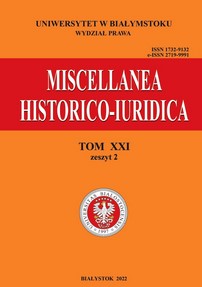Ius caducum w Lublinie w pierwszej ćwierci XVII w.
Ius Caducum in Lublin in the First Quarter of the 17th Century
Author(s): Krzysztof SerokaSubject(s): History of Law, Public Administration, 17th Century, Comparative Law
Published by: Wydawnictwo Uniwersytetu w Białymstoku
Keywords: Ius caducum; escheat; Lublin; bourgeoisie; inheritance; monarch;
Summary/Abstract: The research objective of the study focuses on the functioning of the escheat law within cities. The research, although undertaken in a limited chronological scope, may contribute to the introduction of an issue that has not yet been recognized. The subject of the findings are the detailed issues of the functioning of the escheat law in former Poland, in particular the implementation of the monarch’s prerogative in the light of its limitations imposed in the parliamentary constitutions, the property scope of the escheat law and the issue of the participation of local royal state authorities, i.e. the starost’s office and local (municipal) government authorities, in the execution of the monarch’s decisions. Apart from persons appointed to the inheritance by virtue of law or will, the monarch could also participate in the inheritance proceedings. A heirless or testamentless inheritance fell to the king who, under the law of the escheat (ius caducum), embraced such an inheritance, which was then known in Poland as the “puścizna”. The ruler’s powers in the field of ius caducum were limited by the parliamentary constitutions requiring the king to grant noble goods acquired under the escheat law only to distinguished persons from among the nobility. These restrictions did not apply to the king’s administration and disposal of the bourgeois escheat goods. The process of granting by the king the caduceus estates of the burghers to the nobility are presented on the basis of royal documents concerning the inheritance of Lublin residents passing down to the nobility in the first quarter of the 17th century.
Journal: Miscellanea Historico-Iuridica
- Issue Year: 21/2022
- Issue No: 2
- Page Range: 77-90
- Page Count: 14
- Language: Polish

